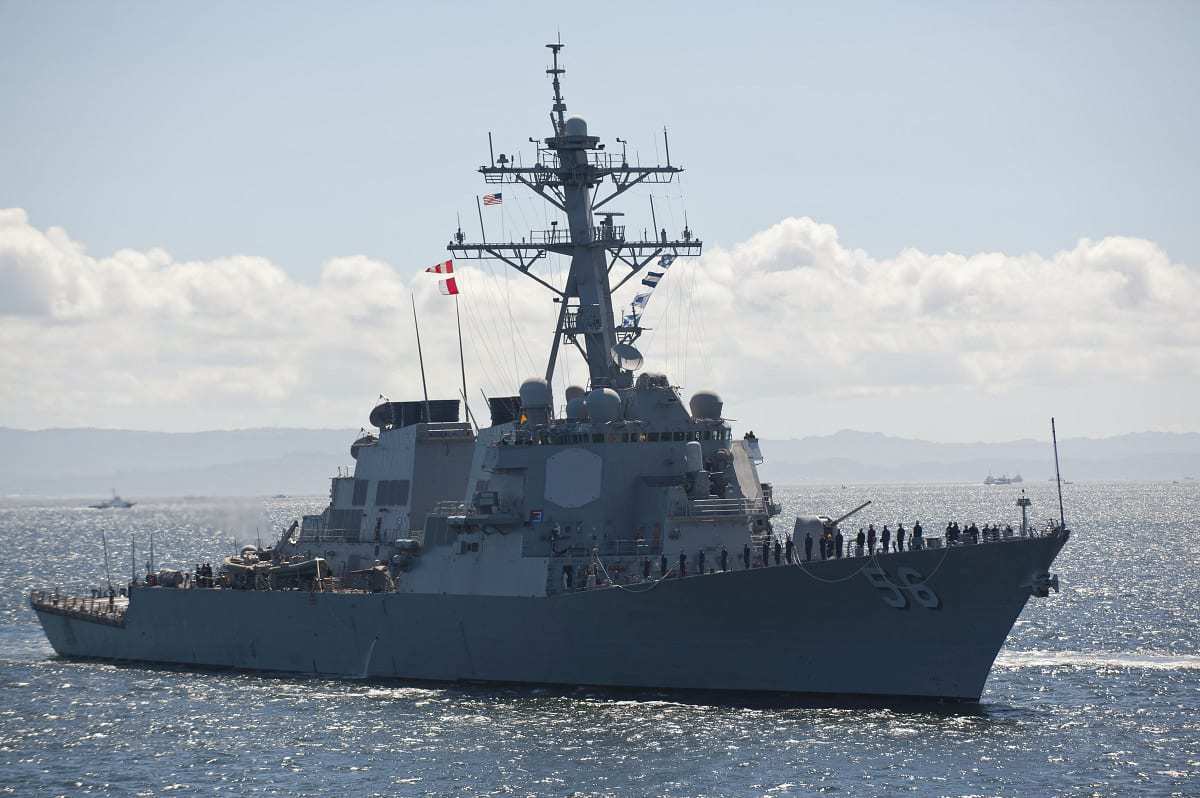When it comes to war, America is almost always playing an “away game.” The conflicts the nation has recently fought, and the defense activities it engages in, are in distant places. There is little reason to suspect this tendency will change anytime soon. Afghanistan and Iraq are both nearly on the opposite side of the globe from the continental United States, and much of the War on Terror over the past two decades has been conducted thousands of miles from U.S. shores. The nations that the 2017 National Security Strategy lists as being of particular concern—China, Russia, Iran, and North Korea—are not only themselves quite far from the United States, but the most likely areas of conflict stemming from these threats—the East and South China Seas, Eastern Europe, the Persian Gulf, and the Korean Peninsula, respectively—are likewise proximate to the potential adversary and quite far from North America.

Image Credit: Author.
With the “away game” being a core feature not only in recent U.S. military history but also likely to persist in coming decades, what can be said about its attributes?
In recent research, we highlight what might be described as a “tyranny of distance” affecting U.S. military performance. In the simplest of terms, America loses when it is fighting far from home. This tendency toward poor military performance at distance from the homeland suggests Americans should consider carefully before embracing intervention.
Kenneth Boulding pioneered the scientific analysis of the political geography of national security. Boulding’s “loss-of-strength gradient” demonstrated the attenuating effect of power projection on military strength. Though Boulding himself thought that perhaps modern technology was gradually whittling away at the loss-of-strength, more recent researchers have demonstrated the persistence of the process in practice (e.g. Buhaug and Gleditsch). In our forthcoming research note in International Studies Quarterly, we show that distance not only continues to matter today, but that it impacts performance as well as power. While exponential leaps in the technology of transportation have made spanning distance easier than ever before, technologies such as satellite surveillance and anti-access and area denial (A2/AD) munitions have recently had the opposite effect, making it more difficult for power projection when operating against a well-equipped adversary. While the actual efficacy of A2/AD technologies is still subject to an active debate—with scholars such as Stephen Biddle and Ivan Oelrich arguing that their effects have been overhyped—it is well accepted that such technologies at a minimum make it more challenging for nations to project power.
Even if one fully discounts the deleterious effects of distance on military power, however, there remain other reasons why distance matters for military performance. There are at least two other processes associated with proximity that mitigate against military success: a loss-of-interest gradient and a loss-of-information gradient. The argument that resolve slackens over distance is intuitive: holding all else equal, a threat closer to home is more alarming than a threat that is far away. Scholars and soldiers throughout history have recognized this when arguing that armies fight harder on their home turf than when invading distant adversaries. The U.S. loss in Vietnam, for example, was not a power projection problem when only considering traditional military strength, but, rather, stemmed from a lack of U.S. resolve. As Andrew Mack argued in the seminal article Why Big Nations Lose Small Wars, “success for the insurgents arose not from a military victory on the ground … but rather from the progressive attrition of their opponents’ political capability to wage war.” While the United States could deploy the full military might of a superpower, it was difficult to convince everyday Americans to support a war in a far off place many had never heard of. In contrast, Vietnamese soldiers exhibited high resolve against superior forces when fighting in—and for—their own homeland. Thus, the Vietnam conflict illustrates the deleterious effect distance can have on achieving foreign policy goals even when traditional superiority helps to address the tyranny of distance.

120822-N-TX154-103
YOKOSUKA, Japan (Aug. 22, 2012) Sailors aboard the Arleigh Burke-class guided-missile destroyer USS John S. McCain (DDG 56) render side honors as they pass by the Ticonderoga-class guided-missile cruiser USS Cowpens (CG 63). Cowpens is part of the George Washington Carrier Strike Group, the US Navy’s only forward deployed carrier strike group, based out of Yokosuka, Japan, and is conducting a routine western Pacific Ocean patrol. (U.S. Navy photo by Mass Communication Specialist 3rd Class Paul Kelly/Released)
In addition to strength and interest, information also decays over distance. The further away a foreign policy interest exists in geographic space, the harder it is to both collect and understand intelligence on the battlefield. Satellites, information technology, and a well-funded intelligence community allow the United States to collect information from across the world, and unrivaled intelligence analysis abilities allow the U.S. government to discern the meaning of this massive amount of information. Even with unrivaled human and signals intelligence capabilities, however, the United States still took nearly a decade to locate Osama bin Laden, erroneously believed Saddam Hussein was actively pursuing weapons of mass destruction, and failed to accurately predict North Korean progress on its nuclear weapon and ballistic missile program. Most recently the U.S. Intelligence Community failed to fully comprehend the magnitude and nature of the emerging respiratory epidemic in Wuhan, China at the end of 2019. A failure to understand the nature of threats is particularly pernicious if one accepts an increasingly compelling argument among conflict scholars that informational problems are a primary cause of war. Consider the Korean War, for example. North Korean forces originally invaded the South in June of 1950 after receiving mixed signals as to whether the United States would intervene to defend the South. After a daring and successful amphibious landing at Inchon, American military forces were able to chase a retreating North Korean army north of the 38th parallel and—in a fit of mission creep—attempted to reunify the country. Whether due to American incompetence or a feigning of weakness on the part of the Chinese, U.S. forces failed to recognize ominous signals that the U.S. advance would trigger intervention by the People’s Republic of China. After three years of fighting, an armistice took place that effectively left the Korean peninsula in the same political position as it was prior to the conflict. Thus, a large, bloody war which ended with a settlement almost identical to the status quo ante bellum was caused not only by a misunderstanding of American resolve by North Korea, but also a misunderstanding of Chinese intentions by the United States. Had these misunderstandings not existed, war could have been shortened or avoided, and millions of lives could have been saved.
Overcoming the decay of strength, interest, and information across distance is a challenging task. But the United States has also had some major successes with this in the past that often go unrecognized. Forward basing and hard power projection assets—such as amphibious assault ships and heavy air transports—have done much to allow U.S. armed forces to maintain strong forward presences in Europe, the Middle East and the Western Pacific for decades. Likewise, American presidents from both parties were able to successfully maintain U.S. public support for overseas defense commitments during the Cold War. There thus exists an ability to overcome a sharp loss-of-interest gradient that might otherwise lead to American isolationism. Indeed, the technical ability of U.S. forces to project power often seems to exceed and even exacerbate the problems of loss of interest and information. With its open democratic system, free press, and internet freedom, the United States has also been able to facilitate information transmission and understanding across the globe, helping other societies better understand America. However, the lack of attentiveness to world affairs characteristic of the U.S. public makes a similar understanding at home of what is happening abroad much more tenuous.
Despite enormous advances in space-spanning technologies, distance remains a daunting challenge. To take but one example, security conditions involving Taiwan—an island roughly 100 miles from mainland China, and over seven thousand miles from the United States—pose all three elements of the tyranny of distance. First, while the United States maintains disproportionate power projection capabilities, the effect of Chinese A2/AD technology on U.S. power projection is also telling in an area so close to Chinese shores. As Admiral Phil Davidson, the current commander of the United States Indo-Pacific Command puts it, “China is no longer a rising power but an arrived great power and peer competitor to the United States in the region.” The Admiral went on to explain that, while China still fields a military that is far inferior to the United States in nominal terms, it can claim rough parity closer to China’s shores, where Chinese power is concentrated. Put another way, distance still matters in power terms, if only because of the amount of territory one must cover, and dominate, to fight far from home. While in decades past—such as during the 1996 Taiwan Strait Crisis—it was clear that a Chinese attack could be beaten back, this is far less obvious to military professionals today.

USS Ronald Reagan is underway off the coast of the Korean peninsula during exercise Invincible Spirit.
Second, the strength of American resolve in defending Taiwan is far from clear. What is clear, however, is that it is less robust than the mainland’s consistent, emphatic claims that it intends to recover the island in order to achieve the “great rejuvenation of the Chinese nation.” Thomas Schelling argued that in a standoff between two states with nuclear weapons, the state with the higher resolve would win. If that is true, then the United States is not in a good position to make compelling threats regarding the status of Taiwan. Lastly, the informational problem is perhaps the most problematic of all. As in the Korean case prior to the 1950 invasion, the U.S. commitment to Taiwan today is ambiguous. Indeed, it is the very policy of the U.S. government to maintain “strategic ambiguity” about what it would do if Taiwan were to be attacked. When it comes to avoiding war, however, ambiguity is bad. As Richard Haass and David Sacks recently argued for Foreign Affairs, it is time for the United States to make its commitment to Taiwan clear, one way or the other.
Playing as the “away team” means that a state faces massive challenges, even in the twenty-first century. The United States thoroughly dominates the security situation in its own near abroad. Indeed, there are few if any adversaries that can credibly challenge U.S. security, let alone its territorial integrity. The areas of remaining interest to the United States are far away from the United States, in terms of its center of power, interests, and knowledge. If the United States continues to engage in distant places, where its power is attenuated, its value for the issues at stake is questionable and its understanding of other actors and context are far from adequate, then it is likely that American military—and by extension political—performance will continue to disappoint. This prediction of mediocrity is consistent with observed outcomes in the recent past: lackluster results in Afghanistan and Iraq, frustrating annexations by Russia in Crimea and by China in the South China Sea, and seemingly undiminished nuclear aspirations in North Korea and Iran. Yet, if the effect of distance is as strong as we assert, there are highly optimistic implications as well. Despite an increasingly globalized world, the United States benefits from extraordinary geopolitical advantages, with two enormous ocean moats and no significant proximate adversary. U.S. allies—even if much closer to potential aggressors—will likewise have strong security. States such as Taiwan, for example, that might otherwise fear the effect distance has even over the mighty United States, can take solace in the argument that the tyranny of distance has considerable effects even across a span as small as the Taiwan Strait. The effect of distance on power thus has a clear bias in maintaining the status quo, which, in a “world America made” is good news for the United States and like-minded liberal democracies.
Patrick Hulme is a PhD candidate in political science at the University of California, San Diego, where he is a Jacobs Fellow and graduate student researcher at the Center for Peace and Security Studies (cPASS). For the 2020–2021 academic year, he is a Hans J. Morgenthau Fellow (non-resident) at the Notre Dame International Security Center and a Junior Scholar at the Carnegie International Policy Scholar Consortium and Network (IPSCON).
Erik Gartzke is a Professor of Political Science and Director of the Center for Peace and Security Studies (cPASS) at the University of California, San Diego, where he has been a member of the research faculty since 2007. Previous permanent faculty positions include Columbia University in the City of New York (2000 to 2007) and the Pennsylvania State University (1997 to 2000). He has held temporary positions at Dartmouth University, the Ecole des Affaires Internationales (Sciences Po), the Naval Postgraduate School, UC Santa Barbara, and the University of Essex.

